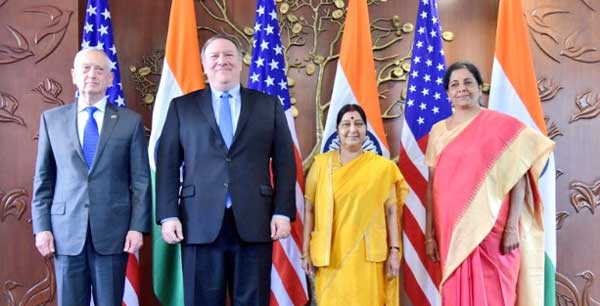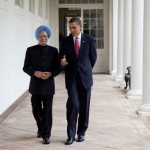The inaugural Indo-US 2+2 Dialogue has happened finally. The media worked overtime, giving minute to minute progress – statements, critical comments and whatnot. As the dust settled there have been multiple articles about the dialogue – some for and some against. But the fact remains that the Indo-US Strategic Partnership will remain ‘one’ of the crucial partnerships for India in years to come, given China’s unabated aggressive moves to achieve its strategic aims of becoming a ‘Great Power’. Details of the 2+2 Dialogue have been adequately covered in media, but there is need to dispassionately examine what really has been achieved, what is overtly being hyped and whether negative criticism is excessive.
The high point of the 2+2 Dialogue was signing of the Communications Compatibility and Security Agreement (COMCASA). The US had wanted to conclude this agreement in 2007, but the text was not approved by the Cabinet Committee on Security (CCS) then. The text had been under discussion since then but what changes, if any, have been made in the text over last 11 years is not known. In 2016, the US had accorder India the ‘Major Defence Partner’ status. More recently, this year the US granted India the Strategic Trade Authorisation-1 (STA-1) to ease export controls for high technology product sales to India; expanding the scope of exports subject to the Export Administration Regulations (EAR) that can be made to India without individual licenses, enhancing bilateral defence trade relationship and result in a greater volume of US exports to India. Notably, the US took two years to grant STA-1 after according ‘Major Defence Partner’ status to India and 13 years after the Indo-US Nuclear deal of 2005 which included US promise to India of easing export controls.
Going by media reports, COMCASA will allow India high-end encrypted communication and satellite data and import of critical technologies. The agreement provides the legal framework for high-end defence technology transfer, for example, India can acquire Sea Guardian drones to detect and target enemy vessels. The encrypted communication and satellite data implies whatever is detected by US warships or aircraft will instantly get transmitted to Indian Navy on secure encrypted receiver at Naval Headquarters. This will certainly enhance intelligence sharing at sea. But what about similar intelligence sharing on land, even if that has lesser priority for the US? Have we sought similar receipt of “instant intelligence” sharing at Indian Army Headquarters under COMSACA or is the agreement ocean specific only?
For India, the movement across and astride the Line of Control (LoC) and International Border (IB) with Pakistan and the Line of Actual Control (LAC) with China should be equally important, if not more, especially where India doesn’t have 24×7 satellite cover astride borders as China has. If we do not have such arrangement under COMCASA, we should ask for its inclusion, given the joint resolve to counter terrorism – terrorist movements, launch pads, and the works. Such intelligence sharing is also relevant to areas like the Doklam Plateau in Bhutan and Chinese activities and buildup along the China-Pakistan Economic Corridor (CPEC), in addition to international borders with other countries. It should be imperative for the 2+2 dialogue and agreements signed to also cover Indian interests, not lopsided to cooperate only on high seas which is the primary US interest.
Discussion on the geopolitical situation and geostrategic situation including the Korean Peninsula, Afghanistan and Pakistan were apparently routine as hitherto fore. Asking Pakistan to stop export of terrorism is akin to directing Imran Khan, Qamar Javed Bajwa and his Generals to convert to Hinduism. The US knows this well and so does India – is not going to happen, especially with Beijing’s blessings to carry on with proxy wars both on India and Afghanistan in order to relive pressure on the CPEC. India and US needed to discuss what beyond – that it did not happen is obvious. The humorous part is media going berserk with headers like “D-Company Ka The End” (D-Company is going to finish). The news about “pressure to be mounted on Dawood Ibrahim” is absurd. There have been some reports of Indian claims in the past like ‘we almost got Dawood’ but the plan was not approved. But the more rational write-ups are that no political party wants Dawood back, at least not alive, for fear of the skeletons that will spill out. Intelligence agencies have details of politicians who have been using hawala for illegal money transactions – as indicated by former R&AW officials without listing names.
But when will India develop resolve to fight its own battles; tackling Dawwod-types and pro-actively combat proxy wars rather than looking towards the US every time? A young veteran recently queried on social media whether Israel with whom we have excellent defence relations, also exports ‘spine’? But even if they do, the recipient hierarchy this side may suffer from ‘system mismatch’. The bottom line is that unless and until we don’t transport the sub-conventional war out of our territory, we will continue to remain at the receiving end. A tweet in circulation by an Israeli Colonel Avner Mueller-Ramat Gan reads, “Every single day I read news about Indian soldiers getting killed by Pakistan army. Do you Indians feel no pain at the loss of the lives of your soldiers? I am specifically pointing fingers at your government. Unless you show the world you can strike back, and with vengeance, the world will keep thinking of you Indians as weak ……. We Israelis respect the life of every single soldier, no matter his or her rank in the IDF”. We may debate origin of this tweet (true or fake) and keep thumping the table about the September 2016 surgical strike, but facts are there to see.
The American support to India seeking membership to the Nuclear Suppliers Group is well appreciated At the same time, it is well known that China will continue to stonewall it, grouping Pakistan with India and continue to rant both must join NPT first. This is despite the fact that China herself has indulged in plenty nuclear proliferation being signatory to NPT. Beijing is also cut up with India having been admitted to MTCR while China continues to be denied. China’s insistence on signing of NPT is absurd because China herself agreed to a NPT waiver in favour of India during signing of the Indo-US Nuclear Deal in 2008. That was after a telephonic conversation between US President George W Bush and Chinese President Hu Jintao. With the ongoing US-China trade war there is little chance of China not opposing anything that US supports. However, before the trade war, had the issue of India’s NSG membership been discussed by President Obama or Trump with Chinese President Xi Jinping, perhaps China may have come around. But US Presidents obviously didn’t consider it necessary.
Prior to the 2+2 Dialogue, media reported Indian concerns about US sanctions on account of the Countering America’s Adversaries Through Sanction Act (CAATSA) and US sanctions on Iran in relation to India importing S-300 Triumf from Russia and oil from Iran would be conveyed during the dialogue on September 6. In early August 2018, US Congress paved the way for waivers to India by passing the conference report on National Defence Authorization Act-2019 (NDAA-19), albeit waivers need to be cleared by the US President. It was stated that CAATSA waiver to India for importing S-300 Triumf from Russia would be one-time, and that US is also granting one-time exemptions from CAATSA to Vietnam and Indonesia who import Russian naval and military aviation systems. After the 2+2 Dialogue, US Secretary of State Mike Pompeo told media, “Our effort here is not to penalize a great strategic partner like India”, adding that Washington was also working with New Delhi to tackle the issue of India’s oil imports from Iran. However, there is no mention of this in the joint statement. Hence, the specter of US sanctions will remain.
For India, relations with Russian and Iran are equally important given the geopolitics and geostrategic dynamics of the region. Indo-US Strategic Partnership will continue to become stronger but India can hardly afford to let shadow of the 2+2 Dialogue impede its economy, rise and national interests.





